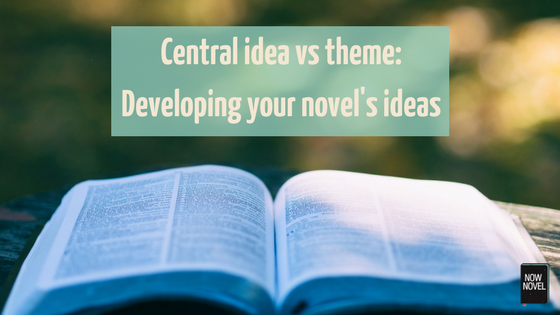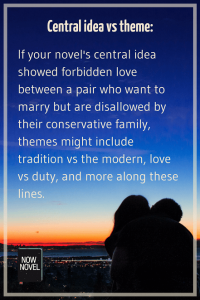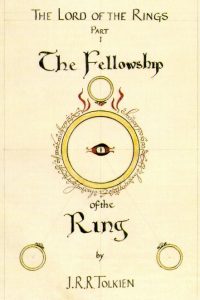The central idea of a story is the seed from which the offshoots of plot, character and theme grow. It’s the core scenario that sets the action in motion. The themes of a novel are the general ideas and principles the story explores. When you examine central idea vs theme, both form the fundamental core of a story – the possible meanings and ideas readers take away. Here are 5 tips for building meaning in a novel using your central idea and themes:
1. Explore the most important themes embedded in your central idea
When you’re writing a novel, choosing a particular scenario as the basis for your story means that certain themes will already be likely.
For example, Dostoyevsky’s novel Crime and Punishment has this central idea: An alienated, poor university student murders a stingy pawnbroker and is tormented by his conscience.
Immediately, this brings in themes: The crime and punishment of the title, for example. Besides showing us his protagonist Raskolnikov’s crime (and the detectives who want to find Raskolnikov to mete out punishment), Dostoyevksy also explores the idea of criminality itself and the judgment and condemnation that comes with it.
For example, it emerges that Raskolnikov wrote a paper as a student that argued people who commit acts that drive historical change should not be held to the same standards of ethical judgment and punishment as those who do not.
If your novel’s central idea showed forbidden love between a pair who want to marry but are disallowed by their conservative family, themes might include tradition vs the modern, love vs duty, and more along these lines.
When you have your central idea, write down the themes that arise from it and sketch how you might explore these themes in the course of your story via your main or secondary plot arcs. The guided prompts in the Now Novel idea finder will help you complete this useful process.
2. Find the ‘message’ implied by your central idea and develop it through scenes
The ‘message’ in the idea for a story isn’t always clear. Sometimes your central idea will simply be the germ for a series of events (for example ‘A boy wakes up one morning to find he can split himself in two and be in two places at once.’) There’s no ‘lesson’ or ‘message’ in this idea itself. Yet in this case, your story will explore the implications of the boy’s new ability. What are its pros and cons? How will this discovery affect his life and the lives of others?
A story like Shakespeare’s Romeo and Juliet, on the other hand, does have a clear message. You could summarise the central idea thus:
‘A girl and a boy from fueding families meet and fall hopelessly in love. Their hostile familial environment leads to tragedy.’
Here there is already an implied message – that unchecked conflict breeds tragedy in love’s place. This is only one way of seeing the message of the story. If you were writing this particular story, however, you could plan scenes that show this message.
To develop the idea that conflict can be unnecessary and destructive and shouldn’t just occur for its own sake, you could write scenes that show:
- Members from both families meeting each other and forming a bond, before realising their compulsory emnity (as the title characters do)
- Fights between opposing members of both families that result in deaths, revealing the true human cost of unrelenting, inflexible conflict (as Shakespeare does)
Once you are drafting your novel, the message and themes of your story will become clearer. As that happens, think about how scenes involving secondary characters and plot points could reinforce or deepen your story’s message.
3: As your story grows, create cheat sheets for your themes
At the outset, you might have an idea of the themes you want to write about. You could equally just want to write and see where your characters and central idea take you. Once your themes start emerging (for example, characters hurt each other and you realize ‘forgiveness’ is a running theme), make your own cheat sheets.
Note down the theme and jot, in point form, plot events in your story so far that illustrate your theme. For example:
Theme: Forgiveness
Explored in: Chapter 7 (Thomas hooks up with someone while travelling abroad on business, Jennifer must decide whether or not she’s willing to give him any more chances).
Once you have a map of your emerging themes, you can find other ways to extend their narrative threads. There could be a scene, for example, showing a time Thomas forgave Jennifer that she remembers. This experience might affect her decision-making in chapter 7.
Theme cheat-sheets will help you keep track of the ideas in your story in a broader, more general frame.
4: Bring in secondary story themes relevant to your central idea
One of the reasons why it’s useful to plan your themes is because good story structure is satisfying. When there are echoes from chapter to chapter or part to part of a book, we also remember which parts of a story are significant.
A secondary theme in a novel is a subject and idea that isn’t the main driving principle of the story but relates to it.
For example, in Tolkien’s The Lord of the Rings cycle, you could say the main theme is the corruptibility of power (the ring and its immense power corrupts most who carry it).
Secondary themes in Tolkien’s work include the importance of friendship and collaboration in overcoming adversity (seen in the motley band of travelers who set off to destroy the ring). Other secondary themes include the idea that courage can be found in the least likely places (the home-loving hobbits become the intrepid adventurers).
This latter secondary theme in LOTR ties into the primary theme of the cycle well. When a corrupt power rises, courage must be found not only in the strongest and most naturally rebellious but the weakest, most ordinary person too (for true, broad opposition). Thus Tolkien’s secondary theme feeds directly into the first, the corruptibility of power. He shows the fact that this dark side of power exists requires each person, no matter how comfortable, to venture outside of their comfort zone and find the courage to defeat tyranny.
5: Decide if the message in your story will be clear or ambiguous
There are many choices to consider when you’re thinking about your themes and the message of your story. As you plan your novel or draft, think about how explicit you want your message to be. Do you want to guide the reader to a specific conclusion, e.g. ‘All power corrupts’? Or do you want to leave your reader freer to decide what the story says and means in general?
If you choose the latter, make sure the narrator does not present information with judgement. For ambiguity, for example, you could present your villain sympathetically. They could simply be another character driven by their own, legitimate motivations and choices. This gives the reader more freedom to decide what the story and its characters’ behaviour and choices mean.
Need to refine your central idea and story themes? Use the Now Novel Idea Finder to brainstorm details and start building a blueprint for your novel.




4 replies on “Central idea vs theme: Developing your novel’s ideas”
Until reading this I didn’t realise that I had an underlying theme to the book I want to write. I have realised that,
1) I have a theme about the dismissal and judgement of perceived disability.
2) I have a hell of a lot more work to do.
Sounds like a useful realization, John. All the best for your book.
With respect !!!
Thank you, Mamaligadoc – the same to you! Thanks for reading our blog. Good luck with your writing for the year ahead.